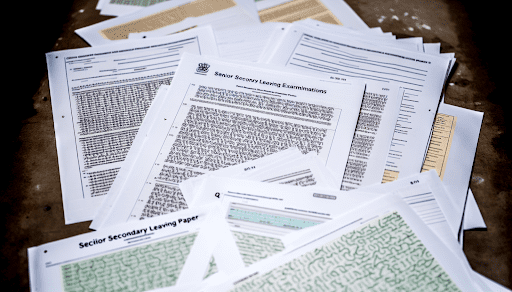
What is a senior secondary leaving examination? It’s a critical assessment that enables students to transition from secondary education to their next steps, be it higher education or a career. This examination measures a student’s proficiency across key subjects and can vary widely by country and educational system. Within this article, you will explore its structure, importance, and the implications it holds for students around the world.
Key Takeaways
- Senior Secondary Leaving Examinations (SSCE) are pivotal in assessing students’ academic abilities and setting the stage for their future educational and career pathways, offering diverse formats and subjects tailored to different educational systems.
- Grading systems for SSCEs vary internationally and encompass various methods, including curving, to ensure fairness and standardization. These grading systems critically influence students’ opportunities for higher education and entry into the workforce.
- Senior Secondary Leaving Examinations provide a range of benefits by establishing clear academic objectives for students, reflecting on the effectiveness of teaching methods, and preparing students for success in higher education and future careers.
Defining Senior Secondary Leaving Examinations

A Senior Secondary Leaving Examination (SSCE) is not just a test taken at the end of secondary school education. It serves as a compass, guiding students toward their future paths by evaluating their academic performance and establishing their qualifications for pursuing higher education or entering the workforce. Whether it’s called the General Certificate of Education (GCE), Higher School Certificate (HSC), or a Baccalaureate, the essence remains the same – a rigorous assessment of a student’s knowledge and skills.
These examinations significantly affect a student’s future, shaping both their academic and career paths. The grades obtained can be the deciding factor in university admissions or alternative pathways into desired fields of study or work. Besides, these exams help in honing essential skills like critical thinking, problem-solving, and decision-making capabilities, laying a solid foundation for their future endeavors.
Role in secondary education
The final year of high school is a milestone, measuring the accumulated learning through the senior secondary leaving examination. This examination is a comprehensive assessment of a student’s academic capabilities, encompassing a broad spectrum of subjects. The Ministry of Education, Culture and Science, or similar authorities, prescribe the compulsory subjects that must be taught during this crucial academic year.
However, the examination process is not restricted to these mandatory subjects. Students are allowed to take examinations in additional subjects, expanding their academic repertoire. The outcomes of these additional subjects are factored into the overall result, computed using the same method as the other exam subjects. Thus, the senior secondary leaving examination serves as a comprehensive assessment of a student’s academic prowess, playing a significant role in shaping their future.
Common types of examinations
Even though the purpose of senior secondary leaving examinations is consistent, their types can vary significantly. National examinations are standardized assessments that are administered to all students enrolled in the same educational program within a particular country. On the other hand, school examinations are assessments created by educational institutions themselves to evaluate the knowledge and academic progress of their students.
The International Baccalaureate (IB) Diploma Programme is another popular option for senior secondary leaving examinations. It is widely recognized and respected worldwide. Introduced in Switzerland in 1968, the IB Programme places significant emphasis on critical thinking, creativity, and intercultural understanding. Enjoying global recognition, it represents a senior secondary leaving examination that transcends national boundaries and educational systems.
The Structure and Format of Senior Secondary Leaving Examinations

The structure and format of senior secondary leaving examinations are as diverse as the students who take them. They vary depending on the country and examination board, encompassing a variety of academic disciplines such as:
- Mathematics
- Science
- Social studies
- Language arts
The quantity of subjects included in these exams also varies, reflecting the diverse academic landscapes across different regions.
Prevalent formats of these examinations encompass globally recognized programs like:
- International Baccalaureate (IB) Diploma Programme
- All India Senior School Certificate Examination (AISSCE)
- Indian Certificate of Secondary Education (ICSE) School Leaving Diploma
Despite the variations in structure and format, the shared goal remains the same – to assess the academic performance of students and determine their readiness for higher education or employment.
Examination boards
A team of committed professionals work diligently behind every senior secondary leaving examination to ensure fairness and consistency. Examination boards, typically under the oversight of the Ministry of Education, Culture and Science or similar authorities, are tasked with the creation and administration of these exams. They are the custodians of academic integrity, establishing clear grading criteria for assignments and exams, and creating reliable and valid exams while maintaining examination security.
Examination boards span across global boundaries, with primary boards like the West African Examinations Council (WASSCE) and the National Examination Council (NECO) in Africa, as well as AQA, OCR, and Edexcel in the United Kingdom. These boards play a pivotal role in upholding the standards of senior secondary leaving examinations and ensuring their recognition on a global scale.
Types of questions and assessments
A distinguishing feature of senior secondary leaving examinations is the variety of question types and assessment methods. Students may be presented with a range of question types including:
- Multiple-choice questions
- Short answer questions
- Essay questions
- Problem-solving questions
Each type of question is meticulously designed to assess distinct aspects of a student’s knowledge and abilities.
The examination board plays a crucial role in determining the format and structure of these examinations, including the types of questions and assessment methods. Some common types of assessments include:
- Multiple-choice questions
- Short answer questions
- Essay questions
- Practical assessments, specific to each subject and notably prevalent in STEM subjects, evaluate a student’s capacity to utilize theoretical knowledge, exhibit practical skills, and participate in problem-solving.
The diversity of question types and assessments ensures a comprehensive evaluation of a student’s academic abilities.
Grading and Scoring Systems

Grading and scoring systems act as the measure of a student’s performance in the senior secondary leaving examination. These systems exhibit significant variations across different countries, with some employing a scale of 0-100, while others may use a scale of 0-10. The grading system can also be impacted by the type of questions, with specific question types leading to deviations from item-writing guidelines and affecting student performance.
Grading on a curve is a method by which grades are modified according to the statistical distribution of exam results. For instance, if the highest score on an exam is 97%, a curve may be applied to establish this as the maximum mark, consequently adjusting all other scores. This approach aids in standardizing performance across various examination cohorts and ensuring fairness in grading.
Grade determination
The determination of grades in an examination is a meticulously balanced process. Countries that employ a combination of school-based assessments and national exams utilize specific grading systems with categories like:
- Excellent
- Good
- Satisfactory
- Pass
- Fail
National exams have a significant impact on determining the final grade, playing a pivotal role in enhancing student achievement and ensuring the transparency of grades in the labor market.
School-based assessments, on the other hand, evaluate students’ academic performance by their teachers over the course of the academic year. The results of this assessment are then factored into the final grade of the senior secondary leaving examination. The grading process utilizes various methods, including standardized achievement tests and continuous assessments monitored through an electronic reporting system by educators.
Pass marks and thresholds
Pass marks and thresholds constitute vital components of the grading system in a senior secondary leaving examination. They are defined as the minimum scores or marks that students must achieve to pass the assessment or receive a specific grade in the subject. The level of difficulty of an exam can indeed have an impact on its pass mark and threshold, with more challenging exams tending to have lower pass marks to account for their heightened difficulty.
The determination of pass marks and thresholds is influenced by factors such as upper secondary curricula, program design, and the overarching goal of fostering student success in higher education. Typically, students are required to attain a minimum score in each subject to pass the Senior Secondary Leaving Examinations. These marks ascertain that students have attained the essential level of knowledge and competence in their subjects.
Benefits and Importance of Senior Secondary Leaving Examinations

Senior secondary leaving examinations are a vital part of a student’s academic journey, offering various benefits beyond serving as a stepping stone towards higher education or the workforce. These examinations establish a specific objective for students to strive towards, aiding them in:
- Recognizing their strengths and weaknesses
- Pinpointing areas for enhancement
- Pursuing their academic objectives in subjects such as mathematics, science, languages, and social sciences.
Moreover, these exams serve as a means to assess the effectiveness of teaching and learning strategies, gauge academic achievement, and foster ongoing improvement within educational institutions. They prepare students by evaluating their academic capabilities, assisting in making well-informed decisions about future education and career paths, and increasing their prospects of pursuing higher education and employment opportunities.
Clear goals and motivation for students
Establishing clear goals greatly motivates students. Research has shown that clear goals are associated with:
- Increased motivation
- Self-esteem
- Self-confidence
- Autonomy in students
The structure of Senior Secondary Leaving Examinations fosters the way students develop competence and autonomy in learning, leading to the cultivation of effective study habits.
These examinations act as a standard, representing the attainment of educational objectives and academic competencies that must be achieved. They establish precise and measurable targets that enhance student performance and underscore the significance of grades in the job market, fostering a purposeful and guided approach to student dedication and learning.
Evaluating teaching and curriculum effectiveness
Senior secondary leaving examinations serve several important purposes:
- They reflect the effectiveness of teaching strategies and curriculum.
- They offer feedback to educators, allowing them to assess the impact of their teaching methods and make necessary improvements.
- The results of these exams reveal strengths and weaknesses in a curriculum, pinpointing areas in need of improvement or areas that are performing exceptionally well.
Schools and educators utilize these examination results to:
- Enhance teaching strategies by analyzing assessment data to identify areas of student struggle and subsequently adapting their teaching approaches
- Impact educational policy and curriculum development
- Motivate teachers and students to strive for improved performance and effectiveness.
Preparing students for future success
Beyond assessing a student’s knowledge, senior secondary leaving examinations equip students for their future. Research indicates that success in these examinations is associated with higher education completion and enhanced employment prospects. The preparation for these examinations aids in the cultivation of academic abilities, critical thinking skills, and subject-specific knowledge, all crucial for achieving success in future careers.
These examinations play a crucial role in fostering the development of a competent workforce by verifying that students have acquired the necessary skills and knowledge essential for the labor market. By evaluating students’ academic performance and establishing their suitability for pursuing additional education or entering the workforce, these examinations guarantee that they satisfy the necessary criteria for success in college, career, and life.
Senior Secondary Leaving Examinations and College Admissions

The student’s journey extends beyond the senior secondary leaving examinations; it is merely the beginning. These examinations are significant in the university admissions process as they provide information about the academic performance and abilities of applicants, enabling universities and colleges to evaluate the knowledge and academic performance of applicants alongside other criteria.
Universities utilize senior secondary leaving examination results to evaluate the academic performance of applicants and make comparisons with other applicants, thereby gaining insights into the applicant’s subject knowledge and proficiency. Each institution may establish its own criteria and weightage for these exams, as detailed in resources such as the UCAS International Qualifications guide and the European Parliament’s comparison of grading systems.
Similarities and differences
Despite sharing the common goal of assessing a student’s knowledge and skills, senior secondary leaving examinations and college admissions exams differ in their focus and scope. Senior secondary leaving examinations typically cover a wide array of subjects, whereas college admissions exams tend to concentrate on specific subject areas pertinent to the desired course or program.
College admissions exams often evaluate a candidate’s aptitude in various areas such as verbal, quantitative, and logical reasoning. They also consider traits like commitment, creativity, critical thinking, initiative, and intellectual curiosity. Thus, while both types of exams serve the purpose of evaluating a student’s readiness for higher education, their methods and focus areas differ, reflecting the different roles they play in the student’s academic journey.
How universities and colleges use exam results
Senior secondary leaving exam results serve as a key tool in the admissions process of universities and colleges. They evaluate these results as a significant assessment that influences admission decisions and helps predict language proficiency, argumentation skills, and structural understanding. Test scores, along with high school performance, including grades and qualitative evaluations of a student’s readiness, are commonly evaluated by higher education institutions.
The majority of U.S. universities utilize a holistic review process in the assessment of college applications through the Common App, taking into account factors such as:
- academic performance
- extracurricular activities
- essays
- personal qualities
However, the significance attributed to senior secondary leaving examinations may differ based on the university and program of study. Thus, while these examinations are significant in evaluating student abilities and determining their eligibility for admission, their importance can vary as they are considered alongside other admission factors.
Special Considerations and Accommodations
Inclusivity is of utmost importance in the field of education. Recognizing this, special considerations and accommodations are available for students during senior secondary leaving exams. These accommodations include:
- Extended time
- Assistive technology
- Alternative exam formats
- Breaks during exams
- A tranquil testing environment
- Assistance for English language learners
These accommodations are particularly important for students with disabilities, chronic illnesses, or language barriers.
For students with language barriers, accommodations include:
- a reduced number of questions
- take-home or group exams
- support for English Language Learners through various aids such as dictionaries
- extra time
- alternate methods of assessment
To acquire accommodations for senior secondary leaving examinations, students or their guardians are required to furnish documentation from a suitable professional, such as a medical doctor, psychologist, or qualified diagnostician, to the examining body.
Types of accommodations
Accommodations for senior secondary leaving examinations strive to provide an equal opportunity for every student. Some common accommodations include:
- Extra time: This accommodation allows students with disabilities who require additional time to complete exams.
- Test reading: Some students may require tests to be read aloud to them.
- Extended time: Students may be given extra time to complete tests and assignments.
- Small group setting: Some students may benefit from taking exams in a small group setting.
These accommodations aim to ensure that all students have a fair and equal opportunity to succeed in their exams.
Assistive technologies available during these examinations may encompass:
- Enlarged or Braille versions of questions
- Voice-activated computers
- Reading pens
- Other aids specifically designed to assist students with special education needs
These accommodations ensure that every student, regardless of their individual challenges, is provided with an equal opportunity to succeed.
The process for requesting accommodations
A well-defined process is involved in obtaining accommodations for senior secondary leaving examinations. Schools or examination boards offer assistance to students by providing detailed instructions on the process of requesting accommodations, which may include completing request forms or reaching out to the relevant department.
The timeline for the submission and processing of accommodation requests is crucial, as the review process may take up to seven weeks. In order to request accommodations, it is necessary to provide documentation such as a diagnosis of the disability, supporting information from qualified professionals, and a rationale for the accommodations. This process ensures that the specific needs of each student are addressed, promoting an inclusive and fair examination system.
Summary
We have journeyed through the labyrinth of senior secondary leaving examinations, unraveling their complexities and understanding their profound impact on a student’s academic journey. From defining these examinations and their structure to understanding their grading systems and significance, we have explored the many facets of these crucial assessments. They not only evaluate a student’s academic performance but also shape their future prospects, motivate them to strive for excellence, and prepare them for higher education or the workforce. As we close this chapter, let’s remember that these examinations are not just tests; they are stepping stones towards the future, paving the way for academic success and beyond.
Frequently Asked Questions
In India, senior secondary leaving examinations are known as SSLC, which is a qualification exam for enrollment to higher secondary school. This certificate is awarded to students upon completion of secondary school level studies
In the Netherlands, school exams include the Cito Examination and the National plus School Examination at the end of primary school, serving as a path to secondary education.
The senior secondary leaving examination is a test that students must pass in order to leave high school. It also often contributes to their overall high school marks.
The purpose of senior secondary leaving examinations is to evaluate students’ academic capabilities and establish their qualifications for higher education or the workforce. This is essential for their future opportunities.
The grades in these examinations are determined based on national exams and school-based assessments, with the results of these evaluations factored into the final grade.







